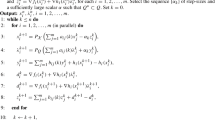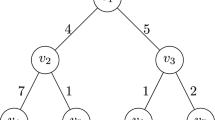Abstract
We describe and compare heuristic solution methods for a multi-stage stochastic network interdiction problem. The problem is to maximize the probability of sufficient disruption of the flow of information or goods in a network whose characteristics are not certain. In this formulation, interdiction subject to a budget constraint is followed by operation of the network, which is then followed by a second interdiction subject to a second budget constraint. Computational results demonstrate and compare the effectiveness of heuristic algorithms. This problem is interesting in that computing an objective function value requires tremendous effort. We exhibit classes of instances in our computational experiments where local search based on a transformation neighborhood is dominated by a constructive neighborhood.
Similar content being viewed by others
References
Ball, M.O., B.L. Golden, and R.V. Vohra. (1989). “Finding the Most Vital Arcs in a Network.” Operations Research Letters 8, 73–76.
Cormican, K.J., D.P. Morton, and R.K. Wood. (1998). “Stochastic Network Interdiction.” Operations Research 46, 184–197.
Festa, P. and M.G.C. Resende. (2001). “GRASP: An annotated bibliography.” In P. Hansen and C.C. Ribeiro (eds.), Essays and Surveys on Metaheuristics. Boston: Kluwer, pp. 325–367.
Fulkerson, D.R. and G.C. Harding. (1977). “Maximizing the Minimum Source-Sink Path subject to a Budget Constraint.” Mathematical Programming 13, 116–118.
Golden, B.L. (1978). “A Problem in Network Interdiction,” Naval Research Logistics Quarterly 25, 711–713.
Hart, J.P. and A.W. Shogan. (1987). “Semi-greedy Heuristics: An Empirical Study.” Operations Research Letters 6, 107–114.
Held, H., R. Hemmecke, and D.L. Woodruff. (2005). “A Decomposition Algorithm for Planning the Interdiction of Stochastic Networks.” Naval Research Logistics 52, 321–328.
Hemmecke, R., R. Schultz, and D.L. Woodruff. (2003). “Interdicting Stochastic Networks With Binary Interdiction Effort.” In D.L. Woodruff (ed.), Network Interdiction and Stochastic Integer Programming, Boston: Kluwer, pp. 69-84.
Israeli, E. and R.K. Wood. (2002). “Shortest-path Network Interdiction.” Networks 40, 97–111.
Krebs, V.E. (2002). “Mapping Networks of Terrorist Cells.” Connections 24, 43–52.
Phillips, C. (1993). “The Network Inhibition Problem.” In Proceedings of the 25th Annual ACM Symposium on the Theory of Computing, pp. 776–785.
Riis, M. and R. Schultz. (2003). “Applying the Minimum Risk Criterion in Stochastic Recourse Programs.” Computational Optimization and Applications 24, 267–287.
Woodruff, D.L. (ed.). (2003). Network Interdiction and Stochastic Integer Programming. Boston: Kluwer.
Yost, K. and A.R. Washburn. (2000). “The LP/POMDP Marriage: Optimization with Imperfect Information.” Naval Research Logistics 47, 607–619.
Author information
Authors and Affiliations
Corresponding author
Rights and permissions
About this article
Cite this article
Held, H., Woodruff, D.L. Heuristics for Multi-Stage Interdiction of Stochastic Networks. J Heuristics 11, 483–500 (2005). https://doi.org/10.1007/s10732-005-3122-y
Received:
Accepted:
Issue Date:
DOI: https://doi.org/10.1007/s10732-005-3122-y




